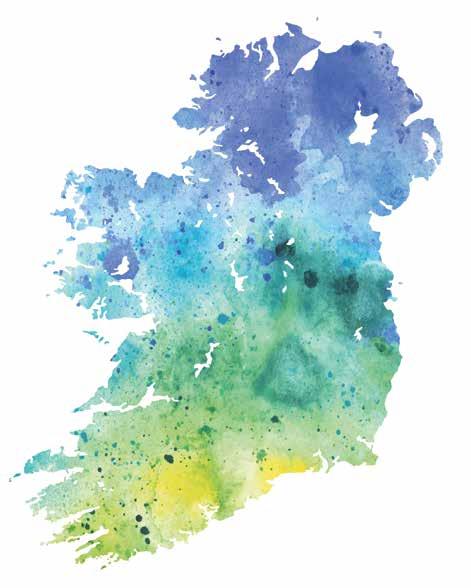
14 minute read
OSTEOPEROSIS
A FRAGILITY FRACTURE SCREAMS CHRONIC DISEASE
David Askin, Clinical Nurse Specialist, Bone Health, Tallaght University Hospital, examines treatment gaps in osteoporosis management
Osteoporosis was on the back foot before the emergence of Covid-19. Leading bone health specialists highlighted a critical care gap in an ageing population with the urgent need to increase screening and instigate osteoporosis treatment in high-risk groups in 2016 (American Society of Bone Mineral Research (ASBMR) 2016). Jane E Brody writing for The New York Times highlighted the perfect storm for broken bones in 2018. In America, osteoporosis treatment is on the decline with less screening in those that had already fractured. From a European perspective, the treatment gap was highlighted in a study in six countries with 60- 80 per cent of patients not receiving treatment following fracture (International Osteoporosis Foundation (IOF) 2018). Harrington aptly described osteoporosis care as "The Bermuda Triangle made up of orthopaedists, primary care physicians and osteoporosis experts into which the fracture patients disappear" (Åkesson et al, 2013). Orthopaedic surgeons rely on primary care to manage osteoporosis, but need to advise them when followup is required. The osteoporosis ex-
perts have no need to interact with the patient during acute fracture management. Fracture patients silently slip away until they present with another fracture. The next fracture can be debilitating causing disability, loss of independence and even death (AMSBR 2016). This tide must turn if the International Osteoporosis Foundation’s vision is to become a reality a "world without fragility fractures in which healthy mobility is a reality for all".
The World Health Organisation was first to recognise the evolving care gap, launching an awareness campaign heralding 2000-2010 as the bone and joint decade. This led to the development of a fracture risk assessment tool known as FRAX in 2007. In the presence or absence of bone density values of the femoral neck a 10-year risk of hip and major osteoporotic fracture is estimated. This led to guidelines and international key performance indicators for osteoporosis management. There is now greater awareness of the disease and guidance on correct management. But is it enough? There remains a significant treatment gap. Acute hospitals managing fractures should provide Fracture Liaison Services (FLS) to identify those at highest risk through investigation and intervention with lifestyle recommendations and treatment where appropriate. This will assist in reducing the burden of disease.
Amongst a wealth of research published on osteoporosis, the most notable is from the National Osteoporosis Society (2014). The qualitative publication stresses the effects of living with osteoporosis. This great unseen disease dramatically effects patient’s quality-of-life. Box 1 highlights thousands of patient’s feelings associated with the disease. Data published from hip fracture registries reports significant increase in morbidity and mortality following hip fractures (NOCA 2018). Of those who were independent prior to fracture 50 per cent require a walking aid. 25 per cent admitted from home require admission to a nursing home for their remaining years. Mortality rates are 10 per cent within 30 days rising to 25 per cent at one year. Therefore, we must provide better care fracture cascade exists as described in diagram 1.
Fractures are common, with prevalence set to increase in line with all other chronic diseases as people live longer. From an Irish perspective fracture rates due to osteoporosis are estimated to be one-in-three for women and one-in-five for men over age 50. The pathogenesis of fractures is complex as osteoporosis is described as a paediatric disease with geriatric consequences (Mitchell at al, 2015). Bone accrual is paramount during childhood and adolescence for later life. For young adults at peak bone mass a cubic inch of bone can endure four times the stresses of a cubic inch of concrete. Yet bone is mischievous, changing, becoming fragile without any sign or symptom. Bone loss is asymptomatic, estimated at around 0.5 per cent-1 per cent per year for women and men. This accelerates for women following menopause, doubling the rate of bone loss for up to 10 years. This is one of many risk factors that increases fracture risk. Increasing prevalence of falls with age also increases fracture risk. 90 per cent of these fractures tend to occur from a fall at standing height or less. This can be considered a mini bone health assessment. If fractures are sustained through this mechanism, they are deemed to be fragility fractures, which increase future fracture risk. This screams chronic disease in post-menopausal women and men over age 50. They can be a symptom of bone loss. Unknown to the patient that suffered this fracture they believe it was just an accidental fall that caused a break that will not happen again.
Selecting the correct patient for
Box 1

Diagram 1

Rheumatoid Arthritis
Steroids
Parental hip fracture High alcohol intake Late menarche
Family history Cigarette smoking Early Menopause Previous fragility fracture 49
180
181
177
418
449
578
592
789
Table 1
treatment is challenging and is probably contributing to treatment gaps in osteoporosis management. This mix-up is fuelled by clinical and quantitative diagnosis of osteoporosis. Key to reducing fractures is knowing risk factors. The osteoporosis mantra for healthcare professionals is fracture begets fracture. It is a red flag for future fracture. The FLS
Medications interfering with bone health Glucocorticoids
Anti-epileptic drugs Proton pump inhibitors Medroxyprogesterone acetate Androgen deprivation therapy GnRH agonists SSRI
Thiazolidinediones
Calcineurin inhibitors
Heparin Secondary causes for osteoporosis Ankylosing spondylitis Diabetes type 1 and 2 Prolonged mobility Inflammatory disease of the bowel Malabsorption diseases (coeliac/lactose intolerance) Thyroid disease COPD
HIV
Organ transplantation
Table 2
at Tallaght University Hospital identifies this as the most dominant risk when performing bone health assessments (table 1). For this reason, recent guidelines from IOF and ESCEO recommend treating post-menopausal women with a prior fragility fracture without further assessment. Osteoporotic fractures are prevalent in certain bones; hip, distal radius, neck of humerus, vertebra (thoracic and lumbar). Significant research at these sites reports a raised risk for future fracture and a clinical diagnosis of osteoporosis. To a lesser extent pelvis and prox

imal/ distal ends of bones are validated. Bones of less consequence are irregular short bones (patella, tarsals and phalanges).
A FRAX calculation and bone densitometry is a more appropriate management in younger post-menopausal women and men under 70 (Kanis et al, 2020).
Bone loss is quantified by DXA (dual x-ray absorptiometry)/bone densitometry. It is the best clinical tool to assist in reviewing fracture risk and response to treatment. Femoral neck bone mineral density is as predictive for hip fracture as high blood pressure is for stroke (Leslie et al 2006). DXA will provide two results - a T-score and Z-score. A Tscore will apply to post-menopausal women and men over age 50. This score evaluates the patient's bone density against young adult peak bone density. A Zscore will identify bone loss in people of the same age. It is applied to pre-menopausal women, men under age 50 and children. An x-ray will report normal bone mass, low bone mass or osteoporosis. This lowest score is used from all three regions; hip, spine or forearm (which is only used if hip and spine are unreliable). The most desirable choice in clinical practice is the femoral neck density.
Bone densitometry was once thought to be the holy grail of management with the operational definition by the World Health Organisation (WHO) T-score of -2.5 or less to diagnose osteoporosis. However, this was used in research for clinical trials and its clinical application was not sensitive enough to predict fractures. Most DXA T-scores for patients attending the Fracture Prevention Service at Tallaght University Hospital with previous fragility fracture report low bone mass of the femoral neck than osteoporosis across hip and lumbar spine sites (table 3). Therefore, based on bone density alone patients would not meet the WHO treatment threshold as there is no osteoporosis recorded by DXA. This has created confusion when selecting the correct patients for treatment. If fragility fractures are sustained at other major osteoporotic sites such as the pelvis, ends of long bones, radius humerus tibia and fibula, treatment should be considered for this group in the presence of low bone mass. This is a diagnosis of osteoporosis as there is a raised risk for fracture. The disease increases fracture risk through loss of micro architectural structure leading to low bone mass and increased susceptibility to fracture (NOGG 2017). A fragility fracture to a hip or vertebra (Thoracic/lumbar) is a clinical diagnosis of osteoporosis. These patients should be offered treatment.
Recent research reports that those who sustain an osteoporotic fragility fracture are at imminent risk of another in the next two years (Kanis 2020). This was addressed through re-categorisation of fracture risk to either low, high or very high risk. Low-risk patients should be reassured with lifestyle advice. High-risk patients should be considered for first line treatment such as bisphosphonate. Very high-risk patients





Normal bone mass
Low bone mass
Osteoporosis
Neck of Femur
210
428
160

might require an anabolic agent. To a degree this is flipping previous management strategies. Previous practice was commencing first line bisphosphonate to slow bone loss reducing fracture risk. However, in theory it would make sense to stimulate a fragile structure to increase its mass. This is now becoming a reality fuelled by the advent of biosimilar anabolic agents, as patency expires for the originator. Data reporting the effect of a first line anabolic agent followed by anti-resorptive can further reduce hip fracture risk (Kanis et al, 2020). The anti-resorptive agent maintains the benefit of the previous anabolic stimulation. It is difficult to see how this could be effectively delivered within the current Irish health system as anabolic agents are currently prescribed through high tech prescription by hospital physicians with a special interest in osteoporosis.
Critical for this patient group is access to fracture risk assessment at the acute hospital or in primary care. This should encompass a multi-faceted health and lifestyle assessment. A f o c u s e d a s -
Total femur
62
126
102
Lumbar spine
285
282
158
420
Table 3
sessment can be directed through the Fracture Risk Assessment tool (FRAX). This free online tool will calculate an absolute fracture risk of fragility fracture with or without bone mineral density measurements in adults between the ages of 40 and 90. It will give direction on who to consider for treatment or lifestyle advice. It can be accessed at http://www.shef.uk/FRAX/tool. aspx?country=48. This tool is validated within the Irish population using epidemiology of fracture and rate of death (McGowan et al, 2013).
Fracture risk is calculated by age, body mass index and well-established risk factors (see Table 1 & 2). FRAX is not perfect and users should be aware of the following limitations: ▸ Falls are not incorporated into this assessment. ▸ It cannot account for dose responses such as alcohol intake, cigarette smoking, glucocorticoid doses and the number of fractures sustained to date (two previous fracture carry higher risk than a single previous fracture). ▸ It can only be used in treatment naïve patients as the algorithm cannot accommodate patients on bone protection treatment who have lowered their fracture risk. Considering these limitations FRAX can underestimate fracture risk and should not remove clinical judgement (NOGG 2017 Kanis et al 2020).
Going forward nurses are the answer to Ireland’s bone health call. Nurses are highly experienced and educated with skills to competently assess patients fracture risk. The ASMBR’s warning address highlighted patients’ hesitancy to commence bone protection treatment due to rare side effects (2016). Many services around Ireland are benefiting from advanced nurse practitioner roles that will drive bone health services into the future. Entwined in this role is establishing rapport with patients, assessing their needs and formulating a management plan with patients. Giving patients the right information and management plan will ease fears and improve compliance.
A similar model of care is developing at Tallaght University Hospital. A nurse led FLS now charges a clinical nurse specialist in bone health who is a registered nurse prescriber to assess patients for future fracture risk and instigate treatment. Nurse prescribing is well established in Ireland since 2007 with the reported benefits documented by Watson and Gethin (2013): ▸ Improved availability to medications for patients ▸ Greater medicinal compliance ▸ Safe and appropriate decision making around the prescription of medicines ▸ Holistic nursing practice
Nurse prescribing can help tackle the challenges faced when managing osteoporosis to instigate treatment in those with the highest risk.
In the coronavirus era, now more than ever, staying fracture-free is critical for anyone with osteoporosis. Healthcare systems are overstretched, with general recommendations urging people to avoid hospitals and doctor’s offices unless treatment is needed or acute illness requires assessment. The Royal Osteoporosis Society has communicated
the following advice - reinforce falls prevention strategies with patients ensuring the home environment is obstacle free.
It is likely that some treatments by injection or infusion for osteoporosis treatment were cancelled, but a temporary delay in medication will not have a long-term effect on bone health (Royal Osteoporosis Society, 2020).
Denosumab should not be delayed for more than four weeks, as the benefits wear off quickly. It should be rescheduled as soon as possible so that the benefits of treatment are maintained. As denosumab is a monoclonal antibody it may cause concern for increased risk of infection. Patients should be reassured it does not suppress immunity. There are no special isolation measures required with denosumab. It does not increase your risk of complications from coronavirus (Royal Osteoporosis Society, 2020).
A video was created to facilitate self-administration of denosumab, available at amgencare. ie. This can be selected for certain patients who should have normal kidney function and may skip pre-treatment bloods if serial levels are normal with regular sources of calcium and vitamin D. Syringes must be disposed of in a sharps box (Royal Osteoporosis Society, 2020).

Regarding intravenous bisphosphonate; Zoledronic acid is a long-lasting drug. It remains active for longer than 12 months, and probably more than 24 months. Most infusion services should be back running at this time and patients should liaise if this infusion is outstanding (Royal Osteoporosis Society, 2020).
Teriparatide injections should continue as normal during the pandemic. Patients who miss a dose should not worry, it will unlikely affect their overall bone health. Restart treatment when the next injection is due or as soon as is feasible. For patients completing two years of teriparatide it is important to discuss a treatment plan with the prescribing team to maintain benefits of treatment (Royal Osteoporosis Society, 2020).
Key to prevention, detection and management of fragility fractures is risk identification. Once risks are identified initial risk calculation by FRAX can help stratify risk. Modify lifestyle where possible. Minimise further risk of fragility fracture with bone protection treatment in high and very high-risk groups within a long term management plan. Remember the red flag mantra; fracture begets fracture.
REFERENCES
Åkesson, K., Marsh D., Mitchell P. J., McLellan A. R., Stenmark J., Pierroz D. D., Kyer, C., Cooper, C. (2013) Capture the Fracture: a Best Practice Framework and global campaign to break the fragility fracture cycle. Osteoporosis International. (24) 2135–2152.
ASMBR(2016) Call to Action to Address the Crisis in the Treatment of Osteoporosis https://www.asbmr.org/advocacy/ sfp-initiative. Accessed online 2020. Brody, J.,E. (2018) Perfect Storm for Broken Bones. The New York Times. Accessed online 2020,
International Osteoporosis Foundation (2018) Broken bones, broken lives – the fragility fracture crisis in six European countries. International Osteoporosis Foundation. Nyon. Johnell O et al, (2005) Predictive Value of BMD for Hip and Other Fractures. J Bone Miner Res. (20)185-94.
Kanis J. A., Harvey N. C., McCloskey E., Bruyère O., Veronese N., Lorentzon M., Cooper C., Rizzoli R., Adib G., Al-Daghri N., Campusano C., Chandran M., Dawson-Hughes B., Javaid K., Jiwa F., Johansson H., Lee J. K., Liu E., Messina D.,. Mkinsi O, D. Pinto, Prieto-Alhambra D., Saag K., Xia W., Zakraoui L., &. Reginster J. -Y. (2020) Algorithm for the management of patients at low, high and very high risk of osteoporotic fractures. Osteoporosis International. (31) 1–12.
Leslie, William D. et al (2006) Effectiveness of Bone Density Measurement for Predicting Osteoporotic Fractures in Clinical Practice. The Journal of Clinical Endocrinology & Metabolism. 92(1):77– 81.
McGowan B, Kanis, John A, Johansson, H Silke, C Whelan, B. (2013) Development and application of FRAX in the management of osteoporosis in Ireland. Arch Osteoporos. 8 (1-2):146.
Royal Osteoporosis Society. Coronavirus and Osteoporosis. https://theros.org.uk/information-and-support/osteoporosis/ coronavirus/ (Accessed online 2020).
Watson C and Georgina G. (2013) Five years of prescribing powers. World of Irish Nursing. 20(02). 24-25.









